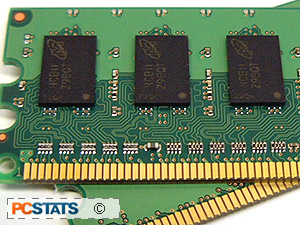What is certain is that DDR2 presents an attractive
option for memory makers, allowing them to ramp up memory speeds (which everyone
wants) while keeping the manufacturing process efficient. DDR2 prices are
currently more than double that of normal DDR, but there is not really a market
for the modules yet, so prices are expected to fall steadily.
It is our opinion that DDR2 is the future of
desktop computer memory, simply for the lack of any other viable choice at this
time. Intel and AMD are going to continue to ramp up the speed of their
CPUs, and DDR2 offers the most effective way for memory to keep pace with
this.
The first platforms for DDR2: Intel's Alderwood and
Grantsdale
 Intel's upcoming i925 Express (Alderwood) and
i915 Express (Grantsdale) chipsets will likely be the first desktop level
DDR2 compatible parts. These two chipsets will introduce a number of new technologies
to the market in addition to DDR2 support.
Intel's upcoming i925 Express (Alderwood) and
i915 Express (Grantsdale) chipsets will likely be the first desktop level
DDR2 compatible parts. These two chipsets will introduce a number of new technologies
to the market in addition to DDR2 support.
They will use Intel's new socket for the Pentium
4 processor, socket LGA775, and it appears that both chipsets
will be PCI-Express 16X only for graphics, lacking AGP interfaces. PCI-Express
will be used for peripherals as well as graphics, with PCI-Express 1X slots
replacing some of the more traditional PCI slots. These will be used for
higher-bandwidth peripherals such as Gigabit Ethernet cards. For more details on
PCI-Express technology, see
our in-depth article here . The twin chipsets should also
serve as a bridge to the new BTX motherboard form factor. Both are
expected on the market in June of 2004.
Indications are that the i925 Express chipset will function
exclusively with DDR2 memory, using dual channels and starting at 533MHz DDR2. The
i915 Express will be capable of both DDR and DDR2 support,
though most manufacturers will likely opt for the safer choice of DDR at
launch.
It's possible, though apparently unlikely according to Intel, that
we could see i915 implementations which support both memory types on the same
motherboard, which would make the chipset an effective path for upgrading.
The i915 will be available in a variety of configurations, some including onboard
graphics.
Other new features are provided by the Southbridge
that Intel has prepared for the chipsets. The ICH-6 Southbridge comes
equipped with 4 PCI-Express x1 channels, as well as the expected Serial
ATA and 10/100 Ethernet. It will communicate with the Northbridge chip
via a new interface, the DMI (Direct Media Interface), a serial
connection that will deliver around 1GB/s in each direction.
More interesting are the variants that Intel will apparently offer for
this chip. The ICH6-W will integrate Wireless access point functionality, allowing the
computer (with the addition of a wireless network adaptor, since the
chipset does not contain an actual wireless transmitter) to function as
the 'hub' of a simple wireless network. Very nice.
The ICH6-R will add hardware RAID 0 and 1
functionality, and double the available serial ATA ports. All versions of
this chip will sport Intel's new 'High Definition Audio' onboard sound,
providing 24-bit, 192Khz audio and up to 15 channels. As we said, look for the first i925 and i915 Express
boards featuring DDR2-SDRAM in June 2004.
Find out about this and many other reviews by
joining the Weekly PCstats.com Newsletter today!
Related Articles
Here are a few other articles that you might enjoy
as well...
1. PMI 4200-512DG PC4200 DDR Memory Review
